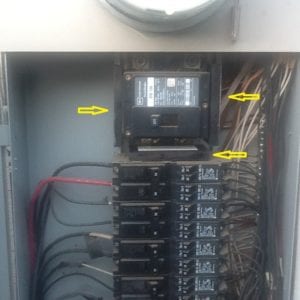DIY Guidelines & Tips
The following sections describe DIY tips, guidelines and ideas regarding our products. Pictures and video of uses of our products will be posted occassionally.
To avoid liability, Bybee Technologies does not get involved in customer design projects or render exact placement recommendations. Bybee products are passive, so the risks are minimal. Soldering skills are recommended for insertion of our line of purifiers.
AC Upgrades
The simplest AC modification is to primary power: Place the purifiers between the AC input — typically an IEC socket — and the transformer input. For best results the recommended procedure is to put a purifier on both the hot and the neutral leg; besides yielding better sound, this will ensure full quantum purification even if the component is connected to an incorrectly wired (out of polarity) AC receptacle. If it is certain that the wall outlet is wired with correct polarity, the purifier on the neutral leg may be omitted, with only minimal decrease in sonic performance. Note: If the equipment is used in a location that has balanced AC power, both the hot and neutral legs must be modified, and a third purifier on the ground will result in optimal improvement.
An even more effective AC treatment is to secondary power: Place purifiers between the transformer and the rectification diodes. The number of purifiers required may vary according to the circuit design of the component. One purifier should be used for each transformer tap utilized. Some users have reported even more impressive results from placing purifiers after the diode bridge.
Note: Treating secondary power is NOT recommended for designs utilizing tube rectification. In such cases it is preferable to modify the primary AC input. Also, when trading secondary power in tube amplifiers, DO NOT place a purifier on the filaments transformer tap.
Outlets with a maximum current draw of 15 A or less may be modified by placing a large purifier on both the positive and neutral connections. This should be done only by a qualified electrician, as there is danger of injury from electrical shock.
Purifiers
All purifiers are passive and they are not directional.
The amount of voltage passing through a purifier is inconsequential. More important is the amount of current. AC Purifiers are designed to withstand AC spikes and are rated for up to 20 amps; the Large purifiers are rated for 15 amps, and the small slipstream purifiers for 4.3 amps. (These ratings reflect the capacity of the leads).
As a general rule, our Quantum Purifiers have proven effective in numerous locations for every type of audio/video component and loudspeaker. Among the most common uses are AC power, audio/video inputs and outputs, and digital inputs and outputs, and loudspeaker upgrades. A good general principle for all installations is to place the Bybee Quantum Purifier as near as possible to the destination end of the AC or signal path.
The Large Purifiers can be used for AC applications where an unexpected spike is not anticipated. To avoid damage from spikes, the AC Bullet/Purifier should be considered. Large Purifiers are acceptable for most all other signal applications. Where space is limited, for instance, with some source components, the small purifiers may be substituted as long as the current flows through them and it does not exceed 4.3 A. It is typically more convenient to use small purifiers in modifying analog and digital circuits, although large purifiers may be used in those applications as well, if space permits.
The following installation options are listed in order of improvement for speaker installations. Option 1 is the best internal speaker modification possible using Bybee products. Option 4 will still produce significant improvements. In all applications, the Bybee product can be soldered, or installed with crimps/connectors.
Option 1) The Ultimate Improvement - One (1) Internal Speaker Bullet installed at, or as near to, the positive (+) tab of each transducer; and one (1) Regular Large Purifier installed at, or as near to, the negative (-) tab of the transducer.
Option 2) The Next Best Improvement - One (1) Internal Speaker Bullet installed at, or as near to, the positive (+) tab of each transducer; and one (1) Regular Large Purifier installed between the cross-over and binding post on the negative (-) leg.
Option 3) Excellent Results - Speaker Bullet Kit (set of 4) - One (1) Internal Speaker Bullet installed between the cross-over and binding post on the positive (+) leg; and one (1) Regular Large Purifier installed between the cross-over and binding post on the negative (-) leg.
Option 4) Good Results - One (1) Internal Speaker Bullet installed on the positive (+) leg only, between the crossover and the binding post.
For optimum performance improvement with RCA jacks, connect a purifier at (or as close as physically possible to) the positive terminal of the jack, and a second purifier on the return leg. Treating only the positive leg will also enhance performance, but to a lesser degree.
For XLR balanced input jacks, both hot and neutral must be treated. For XLR output jacks, best results will come from additionally treating the ground — although here too, the purifier for the ground may be omitted, with some lessening of the performance improvement.
The best results come from treating inputs and outputs. However, if that approach is too expensive, excellent results can still be achieved. As a rule, placing the purifiers at inputs is slightly more effective than putting them on outputs. Note: When upgrading a preamplifier, the input modification should be placed after the selector switch, so that the input signals from all source components get the benefit.
Quantum Signal Enhancers and iQSES
- The iQSEs and Quantum Signal Enhancers (QSEs) can be placed in any position to be effective. Positioning such as upside down or sideways does not effect the units.
- iQSEs can withstand heat inside of components, whereas QSEs are not suitable for inside components.
- Multiple cords, cables, etc can be placed on a single QSE with equal effectiveness.
- Favorable results have been heard near power supplies, placement near and in components, placement on rear terminals of speakers, and just about anywhere a signal path exists.
Here is a picture of 3 iQSEs placed inside a typical US home electrical service panel.
What it is: This new wooden version of the Bybee Quantum Signal Enhancer replaces the popular black acrylic model. Like the original model, this QSE is activated by surrounding electromagnetic energy, but has also been designed and engineered to be more effective by creating an extended electric and magnetic field. Once activated, the extended electric and magnetic fields affects the polarity of all electrons and protons in close proximity; affecting their oscillation by making them more aligned with each other. This reaction creates an affect that makes the transfer or sharing of electrons between atoms more streamline and efficient. The results are a stunningly enhanced purity and energy of the video or audio signal. Of note, the active elements inside the QSE are specially formed crystals that are resistant to damage and will never lose their effectiveness.
How to use it: The Bybee QSE is typically placed under/over any kind of power cord or signal cable. It can be used on televisions, computers, audio equipment; medical equipment or any other source. It is also highly effective when used under/over audio and video components such as CD or DVD players, preamplifiers and amplifiers. It can be placed in any position, and direction of face is not important. The QSE does not necessariy need to be in direct contact with a component to be effective. Also, the plastic packaging, if left in place, does not have an effect on the performance.
The QSE is activated by all forms of surrounding energy. For that reason, the QSE works best when in close proximity to power cords, components, or any other source. This flexibility means that one QSE may be used with multiple cords and/or cables.
Placing multiple cords/cables on the QSE does not reduce it’s effectiveness. However, the effects of the QSE are cumulative – the more QSEs that are implemented in a given environment the more noticeable the results will be.
Benefits Even the best high-definition television or any kind of imaging monitor will display better contrast, visual detail and color fidelity. In audio systems, bass frequencies are faster and more impactful, and high frequencies become more extended, more open and natural, without edginess. The critical midrange sounds more musical, more liquid and less "electronic." The overall presentation of imaging and soundstaging becomes both more precise and more enveloping.
The iQSEs have been reported to benefit the ride and performance of automobiles by improving the computer electronics.
Passive Room Neutralizers and Active Room Neutralizers
The Passive Room Neutralizers (PRNs) and Active Room Neutralizers (ARNs) work exceptionally well together, or they can be used individually. As a general rule, it is recommended to have one PRN for each 50 sq. feet of room. ARNs can be used effectively for up to 100 sq. feet of room. Normally, it is recommeded to place 2 ARNs on wall at about 4' from floor behind each speaker. Both PRNs and ARNs can be placed behind objects, drapes, furniture, etc, without effecting their performance. The soundstage will adjust with each placement, so experimentation is always needed to find the optimum locations.
